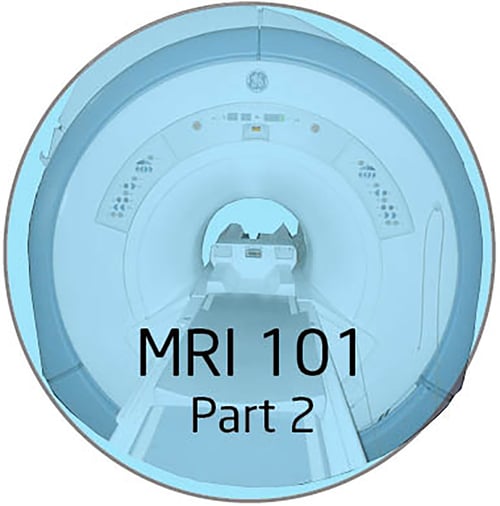MRI is the true workhorse of medical imaging devices. In last week’s blog, we took a first look at the components of MRI equipment. Let’s continue our exploration.
Shimming
For good imaging, you need a homogenous magnet field in which there is a uniform field strength over the image area. Shimming adjusts the magnetic field to make it more uniform. Magnetically susceptible materials located in the magnetic field usually produce inhomogeneities. The presence of these materials are responsible for distortions in the magnetic field that are in the form of inhomogeneities. These can occur in internal and external areas of the field. When a different patient is placed in the magnetic field, some inhomogeneities are produced. External field items like building structures and equipment can produce inhomogeneities. When the external field is distorted, the distortions can be transferred to the internal field where they interfere with the imaging process. These can produce a variety of issues.
It’s not possible to eliminate all of the sources of inhomogeneities, so shimming must be used to reduce them. Some shimming can be done by placing metal shims in appropriate locations when a magnet is manufactured and installed. In addition, magnets can contain a set of shim coils, with shimming being produced by adjusting electrical currents in these coils. As a rule, general shimming is done by engineers when the magnet is installed or serviced. Additional shimming can be automatically done for individual patients.
Magnetic Field Shielding
The external magnetic field surrounding the magnet can be the source of two different types of problems.
- The field is subject to distortions by metal objects like building structures and vehicles. These distortions produce inhomogeneities in the internal field.
- The field can interfere with lots of types of electronic equipment like imaging equipment and computers.
Magnetic field shielding provides a more attractive return path for the external field as it passes from one end of the magnetic field to the other. This happens because air is not a good magnetic field conductor and can be replaced by more conducive materials like iron.
Two Types Of Shielding: Passive and Active
- Passive Shielding is produced by surrounding the magnet with a structure that consists of large pieces of ferromagnetic materials like iron. These materials are a more attractive path for the magnetic field than air. The magnetic field is concentrated through the shielding material located near the magnet, which reduces the size of the field.
- Active Shielding is produced by additional coils that are built into the magnet assembly. They are designed and oriented so that the electrical currents in the coil produce magnetic fields designed to oppose and reduce the external magnetic field.
Radio Frequency System (RF)
The RF system provides a communications link with a patient’s body so an image can be produced. All medical imaging modalities use a form of radiation (like X-ray, gamma-ray) or other energy like ultrasound to transfer the image from the patient’s body. An MRI process uses RF signals to transmit the image from the body. This RF energy is a form of non-ionizing radiation. When RF pulses are applied to the patient’s body, they are absorbed by tissue and converted to heat. The body emits a small amount of the energy as signals to produce an image. The RF signals provide data from which the image is reconstructed by the computer, because the image itself is not formed within and transmitted from the body. The image is a display of RF signal intensities produced by these different tissues.
RF Coils
Within the magnet assembly are RF coils, which are relatively close to the patient’s body. The coils serve as the antennae for transmitting signals to and receiving signals from the tissue. There are three different types of coil designs for different parts of the body: body, head and surface coils. Sometimes the same coil is used for both transmitting and receiving and at other times, separate coils are used for transmitting and receiving.
Surface coils produce better image quality than body and head coils can. These surface coils can be in the form of an array of several coils or just single coils. Each has its own receiver circuit operated in a phased array configuration, which produces the high image quality obtained from small coils but with the added advantage of being able to cover a larger anatomical region with faster imaging.
Transmitter
RF energy is generated by the RF transmitter, which is applied to the coils and then transmitted to a patient’s body. A series of discrete RF pulses generate the energy. A transmitter consists of several components like power amplifiers and RF modulators and must be capable of producing high power outputs of several thousand watts. The RF power required is determined by the strength of the magnetic field and is proportional to the square of the field strength. That means a 1.5 T system would require nine times more RF power applied to a patient than a 0.5 T system. The transmitter has a power monitoring circuit, which is a safety feature that prevents excessive power being applied to a patient’s body.
Receiver
After a sequence of RF pulses are transmitted to a patient’s body, the resonating tissue will respond by returning an RF signal. These are picked up by the coils and then processed by the receiver. The signals get converted into digital form. They are then transferred to a computer for temporary storage.
RF Polarization
An RF system can operate in a circularly polarized mode or linear mode. Quadrature coils are used in a circularly polarized mode, consisting of two coils with 90 degrees separation. This will produce improved excitation efficiency by producing the same effect with half the RF energy or heating to the patients, as well as producing a better signal-to-noise ratio for the received signals. By surrounding it with an electrically conducted enclosure of sheet metal and copper screen wire, an area can be shielded against external RF signals. The principle behind RF shielding is that RF signals can’t enter an electrically conducive enclosure. However, the thickness of the shielding isn’t a factor. Even thin foil can serve as a good shield. However, the room has to be completely enclosed by the shielding materials without any holes whatsoever. In addition, the imaging room doors are considered part of the shielding and must be closed while images are acquired.
Computer Functions
An integral part of any MRI system is a digital computer, which performs and controls the production and display of MR images. Here are the specific steps that are controlled and performed by your computer.
Acquisition Control
During the acquisition process, there are many repetitions of an imaging cycle. During each cycle, a sequence of RF pulses is transmitted to the patient’s body. The gradients are then activated and RF signals collected. It’s important to note than one imaging cycle doesn’t produce enough signal data or information to create an image, so the cycle must be repeated multiple times. The time needed to acquire images is determined by the duration of the imaging cycle or repetition time. This adjustable factor is known as TF. The number of cycles used affect the image quality, with more cycles producing better images as a rule.
The acquisition process is controlled by protocols stored in the computer and the operator can select from preset protocols.
Image Reconstruction
During the acquisition phases, the RF signal data is not in the form of an image but the computer can use this collected can be data to “reconstruct” an image. This is known as a Fourier transformation. It’s a mathematical process that is relatively fast and usually doesn’t have a significant effect on the total imaging time.
Image Storage and Retrieval
The reconstructed images are stored in the computer, where the images can be used for additional processing and viewing. Your storage media determines how many images can be displayed or stored.
Viewing Control and Post Processing
Your computer system controls the display of the images, making it possible for a user to select specific images and control viewing factors like windowing (contrast) and zooming (magnification). This allows the user to reformat an image or set of images or change the display in order to produce specific views of anatomical regions. Much post processing is performed on a workstation computer in addition to the computer system in the MRI system.
Talk To An Expert
Does your hospital, urgent care, clinic or veterinary practice need an MRI system? If so, oftentimes a refurbished MRI system can provide the performance you want for a much lower price point. Talk to one of the experts at Atlantis Worldwide and see if this can be a solution for you.
Contact Atlantis Worldwide today.
Some blogs you may have missed:
- The Future of Helium & MRIs
- MRI Cold Head Tips
- Service Contracts for Imaging Systems: Penny Wise and Pound Foolish?
- Radiologists, Healthcare & Social Media
- Should your business lease or buy medical imaging equipment?
- Free MRI Resources
Meet the author: Vikki Harmonay



